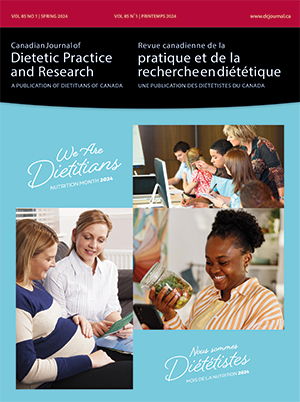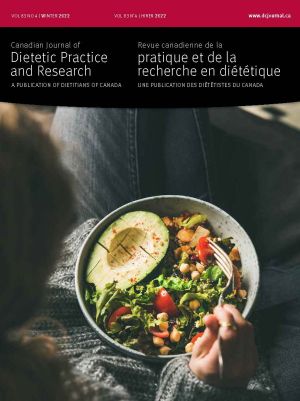Volume 64 • Number 4 • December 2003
Chair’s Message
Research
To determine whether older Quebecers are eating adequately and whether summary scores represent diet quality, a representative subset of participants aged 55 to 74 (weighted n=460, 47% male) was studied from the 1990 Enquête québécoise sur la nutrition dataset. Participants’ diet quality was scored from adjusted 24-hour recalls. Foods were coded into Canada's Food Guide to Healthy Eating food groups. Usual Dietary Adequacy Score (maximum=18) and Dietary Diversity Score (maximum=4) were calculated from adjusted food guide portions and validated internally in relation to achievement of nutrient recommendations using correlation analysis. Average usual Dietary Adequacy Score (mean ± standard error) was 14.96 ± 0.15 (men) and 13.72 ± 0.15 (women). Only 7% of men and 1% of women achieved the maximum usual score. Fortyfour percent of men and 45% of women scored a usual Dietary Diversity Score of 3, and 55% of men and 50% of women achieved 4. Thus, approximately half of older Quebecers showed inadequate dietary variety, and consumed fewer than the minimum recommended number of servings from certain food groups. Summary diet quality indicators are useful for tracking diet quality, and provide critical data for planning nutrition education programs targeting older persons.
Research on relationships between socioeconomic status and Canadians’ diet is limited. The current study investigated differences by education in dietary variables shown to be related to obesity; it included three age groups of Saskatchewan women who participated in the 1992 to 1993 Heart Health Intervention Evaluation baseline study. Multistage sampling was used to select randomly from the Saskatchewan Health Insurance Registration File. The overall response rate was 42.6%; a sample representative of the general Saskatchewan population was obtained. Three-day estimated food records and demographic information from 396 women aged 18 to 74 years were subdivided into three age categories: 18 to 34 years, 35 to 54 years, and 55 to 74 years. For the 18- to 34-year group, obesity was significantly more prevalent with lower education; trends were similar for the older age groups. Under-reporting of energy intake (indicated by an energy intake:basal metabolic rate ratio of <1.1) was related to obesity but not to education. The greatest differences in diet between educational groups were observed in the 18- to 34-year group; fewer differences existed in the 35- to 54-year group, and none in the 55- to 74-year group. Health promotion efforts need to be targeted appropriately, and based on differences in dietary intakes by socioeconomic group. Research should help promote an understanding of the reasons for differences in diet by socioeconomic status.
Periconceptional folic acid intake: evaluation of a promotional program This study evaluates the efficacy of a regional program promoting periconceptional folic acid intake. Data were collected through a self-administrated questionnaire among 721 (405 for phase I; 316 for phase II) primiparous women. For phase I, 26.1% (CI [Confidence Interval] 95%: 21.9% – 30.4%) of respondents took an adequate periconceptional folic acid supplement, whereas this proportion was 31.6% (CI 95%: 26.5% – 36.7%) for phase II (p > 0.05). For phase I, 62.0% (CI 95%: 57.3% – 66.7%) of women recognized the role of folic acid. For phase II, this proportion significantly rose to 70.9% (CI 95%: 65.9% – 75.9%). Regional activities promoting periconceptional folic acid intake, if maintained, should be modified to significantly increase the proportion of women taking an adequate amount of folic acid.
The purpose of this study was to quantify nutritional risk in a convenience sample of vulnerable, community-living seniors, and to determine patterns of nutritional risk in these seniors. The sample consisted of 367 seniors who provided health, functional, and nutritional risk information during an interview in which the Seniors in the Community: Risk Evaluation for Eating and Nutrition questionnaire was used. The majority (73.6%) of the sample was female, and the mean age was 79 years. Nutritional risk was identified in 68.7% of the sample, with 44.4% being at high nutritional risk. Common nutritional risk factors were weight change, restricting food, low fruit and vegetable intake, difficulty with chewing, cooking, or shopping, and poor appetite. Principal components analysis identified four independent components within the Seniors in the Community: Risk Evaluation for Eating and Nutrition questionnaire; these components can be described as low food intake, poor appetite, physical and external challenges, and instrumental activity challenges. Data are sparse on nutritional risk in community-living Canadian seniors; despite methodologic limitations in the recruitment process, this study provides some indication of the level of nutrition problems. The patterns of nutritional risk identified in this vulnerable population may help providers identify useful strategies for ameliorating risk. The Seniors in the Community: Risk Evaluation for Eating and Nutrition questionnaire could be used to identify risk and patterns of risk in Canadian seniors, so that treatment could be individualized.
Eat Smart! Ontario's Healthy Restaurant Program is a standard provincial health promotion program. Public health units grant an award of excellence to restaurants that meet designated standards in nutrition, food safety, and non-smoking seating. The purpose of this study was to assess whether program objectives for participating restaurant operators were achieved during the first year of program implementation, and to obtain operators’ recommendations for improving the program. Dillman's tailored design method was used to design a mail survey and implement it among participating operators (n = 434). The design method, which consisted of four mail-outs, yielded a 74% response rate. Fifty percent of respondents operated family-style or quick-service restaurants, and 82% of respondents learned about the program from public health inspectors. Almost all respondents (98%) participated in the program mainly to have their establishments known as clean and healthy restaurants, 65% received and used either point-of-purchase table stands or postcards to promote the program, and 98% planned to continue participating. The respondents’ suggestions for improving the program were related to the award ceremony and program materials, media promotion, communication, education, and program standards. Program staff can use the findings to enhance the program.
Perspectives in Practice
The implementation of school nutrition policies poses a challenge to dietitians as they work with schools to increase the availability of nutritious foods. An analysis of the implementation of the Food and Nutrition Policy for New Brunswick Schools, proclaimed by the department of education in 1991, revealed four factors that influenced implementation: selling food for profit, student choice, interpretation of the policy, and the approach to implementation. From 1997 to 1999, data were obtained from 50 participants at the provincial, district, and school levels through semi-structured interviews; supporting evidence was obtained through a review of pertinent documents. The policy goal was to develop good eating habits among schoolchildren. The policy objective to have all food services follow national guidelines for healthy eating was so controversial that implementation was inconsistent and had little impact on school foods. Opponents objected when the sale of certain foods was curtailed, felt the policy limited student choice, were unsure how to interpret it, and resented the department's top-down approach. Dietitians, who had minimal involvement with the New Brunswick policy, need to consider carefully how to work with educational agencies to combine support and pressure to foster the capacity and willingness of schools to implement nutrition policies.
Report
In 1998, Dietitians of Canada and the team of registered dietitians at Kellogg Canada Inc. partnered to develop Mission Nutrition ®, a national bilingual nutrition education program that provides curriculum-based resources to teachers. The main objectives of this study were to measure the awareness and utility of the Mission Nutrition® program among elementary teachers, and to identify opportunities to enhance the Mission Nutrition ® resources to increase use. A ten-minute telephone survey was conducted with a representative sample of 203 elementary school teachers. A sub-sample of 20 teachers then participated in a more in-depth 30-minute telephone survey. A need for increased promotion of the Mission Nutrition® program was identified on the basis of the 22% awareness among teachers participating in the initial interview. All teachers who had used the educator guides and student activity sheets reported that they would use them again. Teachers found that the Mission Nutrition ® materials were wellresearched and contained useful activities relevant to students. The findings indicate that, to be most effective, nutrition education resources should be provided in a ready-to-use format and integrated with core curricula. Teachers also suggested that materials should include fresh ideas to engage students at different grade levels, and ways to involve parents. Dietitians are ideally positioned to work collaboratively with educators to develop these types of nutrition education resources.










